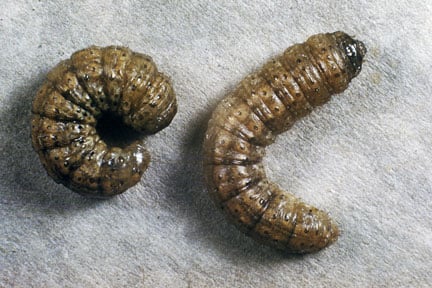
Quick facts
Common name - Cutworms
Plants affected - Various
Main symptoms - Stem bases are eaten
Caused by - Caterpillars of several species of moth
Timing - All year
What are cutworms?
- Cutworms are the caterpillars of a number of different moths who live in the soil and tend to feed at the base of plant stems. Species that are often found in gardens include the turnip moth (Agrotis segetum), large yellow underwing (Noctua pronuba) and the heart and dart moth (Agrotis exclamationis)
- Populations of these moths often go unnoticed in gardens and are part of the biodiversity gardens support
- The caterpillars of these moths are similar in appearance, growing up to 40 mm long they are usually greyish-brown in colour, but can be pale green or creamy-white. They have three pairs of legs at the head end and five pairs of clasping prolegs on their abdomen, although these are often concealed as cutworms usually curl up when disturbed
- In general these moths lay eggs during the summer and the caterpillars either pupate in the autumn or overwinter and complete their feeding in the following spring. The caterpillars can however, be found at any time of year

Symptoms
- Caterpillar feeding damage often goes unnoticed and populations of these moths are part of the biodiversity gardens support
- The stems of some annual plants may be girdled or the roots severed at ground level
- Cutworms also feed above ground at night whenever the weather is mild, particularly on the leaves of low-growing herbaceous plants
- In summer cutworms can feed in the vegetable garden on lettuce roots, potato tubers and other root vegetables. Similar damage can be caused by slugs, vine weevil, chafer grubs and voles. When plants suddenly wilt the cutworm is often easy to find beneath the affected plant
Management
Check susceptible plants frequently so action can be taken before a damage has become serious.
- Where possible tolerate some damage from these insects, they are part of the biodiversity a healthy garden can support. Caterpillars and the adult moths form the basis of many food chains
- Encourage predators and other natural enemies of caterpillars, in the garden, such as birds, ladybirds, wasps (social and parasitoid) and ground beetles. The caterpillars, and adult moths, are important as a food source for other garden wildlife
- The adult moths often prefer to lay eggs where there is a dense vegetation cover, and so they occur in the largest numbers in neglected areas or where turf has been dug up to make a vegetable or flower bed
- Cultivation can briefly expose the grubs to some predators, such as birds
- Remove caterpillars from soil as they are found
- Cutworms are very vulnerable to rain or irrigation when young. Well watered vegetable plots are often free of damage
- A warning service is used by commercial growers to apply timely irrigation
- Crops grown beneath fleece or insect-proof mesh are less likely to be affected
Biological Control
A mixture of nematode species for controlling caterpillars and some other vegetable pests is sold as Fruit and Vegetable Protection and is available from some biological control suppliers. The biological control is not specific to caterpillars and other insects may be affected. To be effective the nematodes need to be watered into moist soil while soil temperatures are in the range of 12-20ºC as soon as possible after purchase/delivery. These temperatures occur between April and September. Nematodes should be applied as soon as possible after purchase, following the suppliers’ instructions. It may be necessary to water the soil before and after application to ensure the soil is sufficiently moist for nematode activity and survival. Repeat application may be necessary.
Download
Biological control suppliers (pdf document)















